Shops make a city great
The missing piece in our urbanist discussion.
Eight years ago, around the time I moved to San Francisco, I watched the Disney movie Big Hero 6. It’s set in a city called “San Fransokyo”, which is supposed to be a mashup of two of my favorite cities — basically a denser San Francisco with some Japanese-style roofs and electric signs:
Around that same time, I became acquainted with the YIMBYs, who onboarded me into the broader urbanist revival that was happening throughout the United States. I spent years thinking about what it would take to turn San Francisco into San Fransokyo. And I wasn’t the only one. Plenty of discussions of San Francisco’s urban future reference that same Disney vision.
Over the past two years, my thinking on what makes cities great has advanced a great deal. Although American urbanists usually think in terms of housing density — which is understandable, given the country’s failure to build enough housing — I’ve come to realize the importance of commercial density. Basically, great cities have a lot of shops everywhere.
I wrote about this in the context of Japanese cities about a year ago:
American zoning tells you what you are allowed to build in an area — single-family homes, office buildings, etc. — while Japanese zoning specifies what you’re not allowed to build. This means that almost every zone is mixed-use — since almost no zones outlaw every possible type of shop, almost every zone has some stores in it. In other words, in America, relatively few areas can have stores, because the zoning laws have to specifically tell you “It’s OK to build a store here”. In Japan, if the zoning code doesn’t expressly forbid stores, you can go ahead and build them…Because almost every area has stores and restaurants, even in the suburbs, you’re never far from a store or restaurant…
Of course, all of this requires something besides mixed-use zoning — it requires high commercial density…We tend to think of “density” as residential density — the number of people who live in a given area. But as the blog Urban kchoze argues, commercial density — the number of shops in an area — is very important for walkability…Japanese cities, in contrast, have a ton of little stores and restaurants…[This] creates a variety of stores in a neighborhood. If every convenience store and noodle shop has to be small, you have to have a lot of them in order to serve local demand. And this creates local variety, which is fun and enjoyable.
And in a follow-up post, I wrote about how Japan’s high commercial density comes from favoring small businesses:
[I]n Japan, when you go out to eat, there are a million restaurants to choose from, and they’re all near each other. When you go clothes shopping, there are a million little boutiques to try, and they’re all near each other…The romance of urban Japan is that there are always a bunch of completely new places to discover, and so it’s always worth walking around and discovering stuff…
And that couldn’t happen unless there were a huge number of people who wanted to start small businesses…Japan has a number of government policies in place to support small retail businesses over large ones. One of these is the Large Store Law, which discourages big stores in dense urban areas. But there are many others. There is a vast and diverse array of subsidies and supports targeted specifically at small retail businesses — startup cost assistance, renovation assistance, low-interest loans, tax incentives, training for small business entrepreneurs, community preservation laws, and so on…
Besides making urban environments pleasant and exciting, it seems to me that small business owners provide a crucial constituency for many of the essential ingredients of Japanese urbanism…
For example, take public safety…Small businesspeople…have an interest in policies that promote public safety, which is one of the key elements of Japan’s excellent cities…Another example is walkability…[I]t’s in the interests of small businesspeople to have great trains, walkable spaces, and residential density, in order to get them more customers…And small businesses create the ultimate constituency for capitalism itself…Small business turns a large mass of the middle class into capitalists, giving them a direct stake in the system of private business ownership.
I think Japan has executed on commercial density incredibly well. If San Francisco had a few blocks full of Japanese-style zakkyo buildings, I think it could be pretty iconic. But in fact, I think every big city could benefit from encouraging small retail business, even if it doesn’t look quite like the Japanese model.
Housing without shops is sterile, whether it’s dense or not
Every YIMBY who advocates for greater housing density encounters people who attack new housing on aesthetic grounds. American zoning laws and building codes have incentivized developers to build a certain kind of short, bulky apartment building called a “5-over-1”.1 These have become the standard type of new apartment across all of the United States, and they’re instantly recognizable:
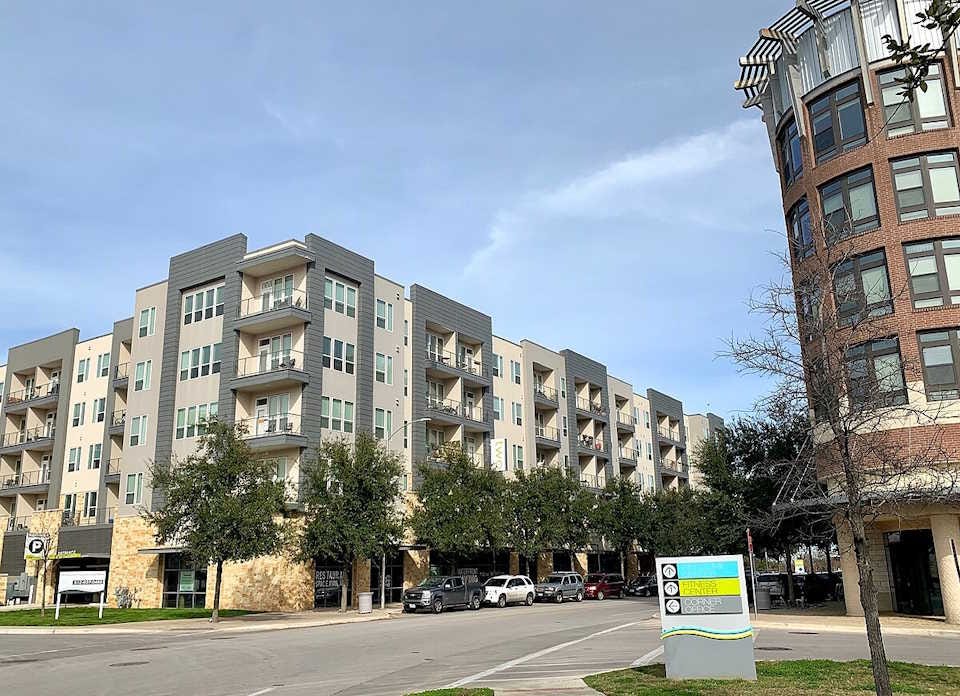
A lot of people don’t like this style of building, and some use this aesthetic distaste to argue against new housing construction. But I doubt that replacing it with something more ornate — in the style of, say, Brooklyn brownstones, or Paris’ Haussmannian apartments, would do much to quiet these objections. Instead, I think most of what the naysayers are really objecting to isn’t the color or the facade material or the lack of ornamentation — it’s the urban design around these new buildings.
America doesn’t have a lot of public transit, so the people who live in 5-over-1 buildings tend to drive most places. The buildings are thus built with car accessibility in mind — surrounded by large roads and parking lots. The roads and parking lots are ugly, and they make the buildings themselves look isolated and bare, which also makes them seem less aesthetic.
You can put shops on the ground floors of the 5-over-1 buildings, and in fact many do that. But as Alfred Twu writes, both the design and the typical location of the buildings limit how many shops they can sustain:
[T]he ground-floor retail spaces of 5-over-1s can be hard to lease since they’re often oddly shaped to fit around parking, stairs, and other service spaces. And five floors of apartments don’t house enough people to support a whole floor of retail: a two-person household living in a 600-square foot apartment only creates demand for ten square feet of urban retail. Another issue is that many large-scale 5-over-1 developments are located in former industrial areas with little or no preexisting retail traffic or destination retail.
Looking at a 5-over-1 complex thus conveys a sense of isolation — it tends to look like a place where you’d mostly be hunkering in your room or leaving to drive to a far-off destination. And if you’re going to live that lifestyle, why not just live in a single-family home, where at least you have more space and more greenery?
On the flip side of this coin, many YIMBYs love to post pictures of the suburbs, with their endless rows of single-family homes, and to comment on how sterile they look. They’re not wrong, but I suspect that any form of housing that only has houses and not shops will look pretty sterile. For example, here are some typical apartment blocks in Korea:
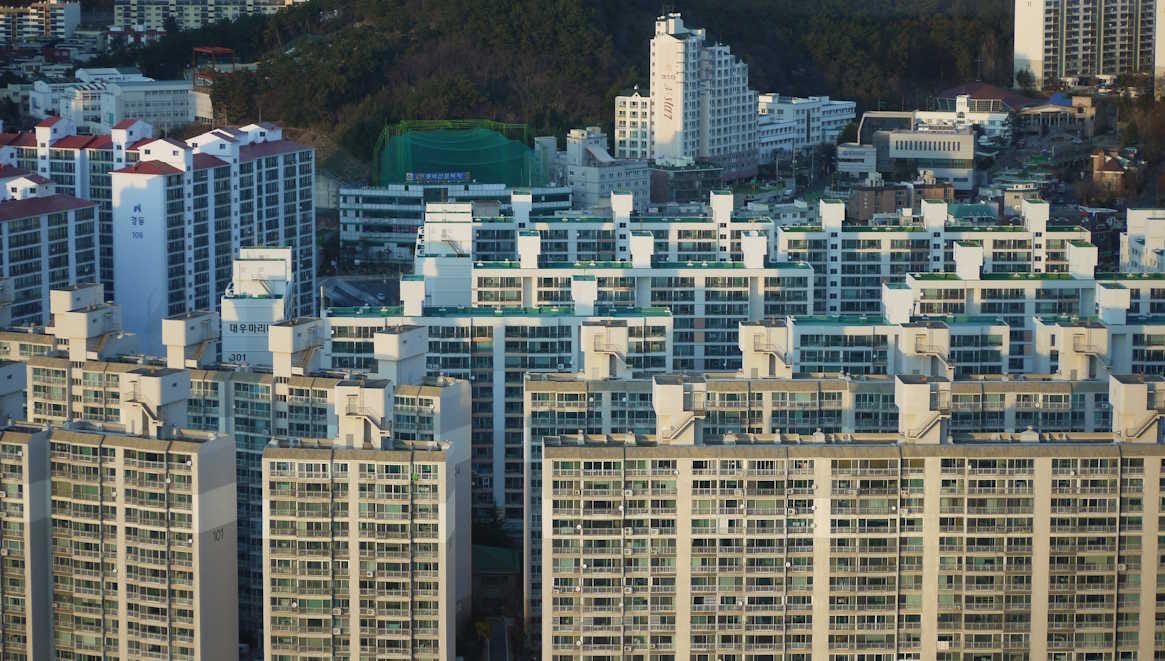
And here’s a xiaoqu superblock in China:
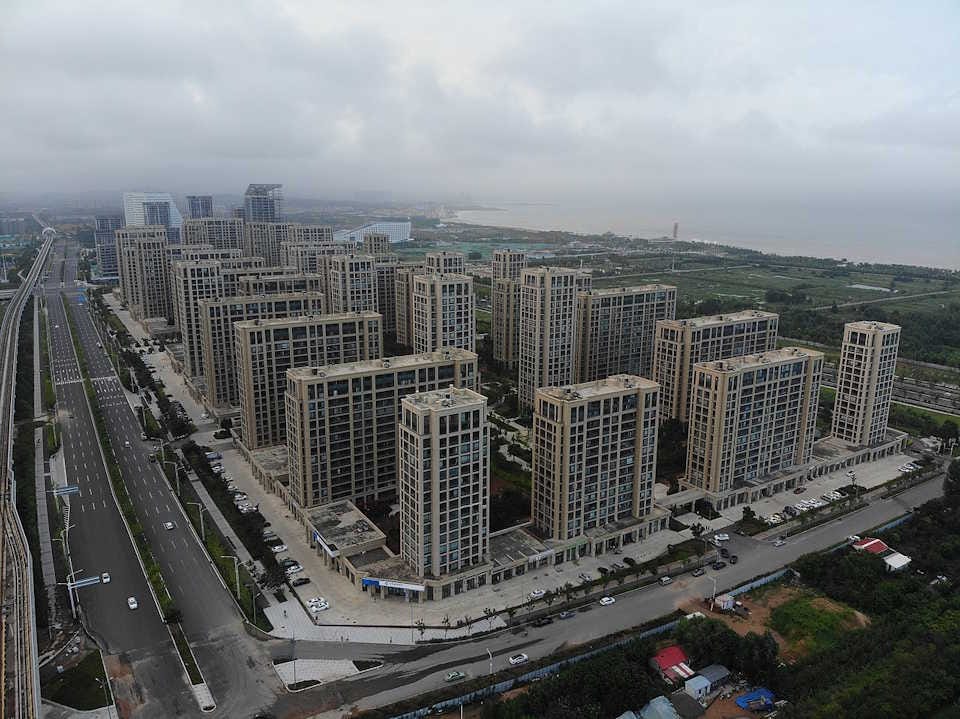
Many of these xiaoqu districts have a little bit of retail in them — some grocery stores or other sources of basic necessities, a few restaurants, etc. But the commercial density is still very low; these are spaces built to house people, not shops. If you want to get to anywhere with some real variety and novelty, you’re going to have to leave and drive (or make your way to a train or bus station and take transit) to a mall.
The beauty of Brooklyn’s brownstones, or Paris’ Haussmann apartments, comes in large part from the fact that they’re located near to shops. When you see those narrow streets in front of the Brooklyn apartments, you know they’re built for walking. And that implies that a short walk away, there will be some place like this with some shops:

Paris’ Haussmann apartments are usually either very close to shops, or built right above them:
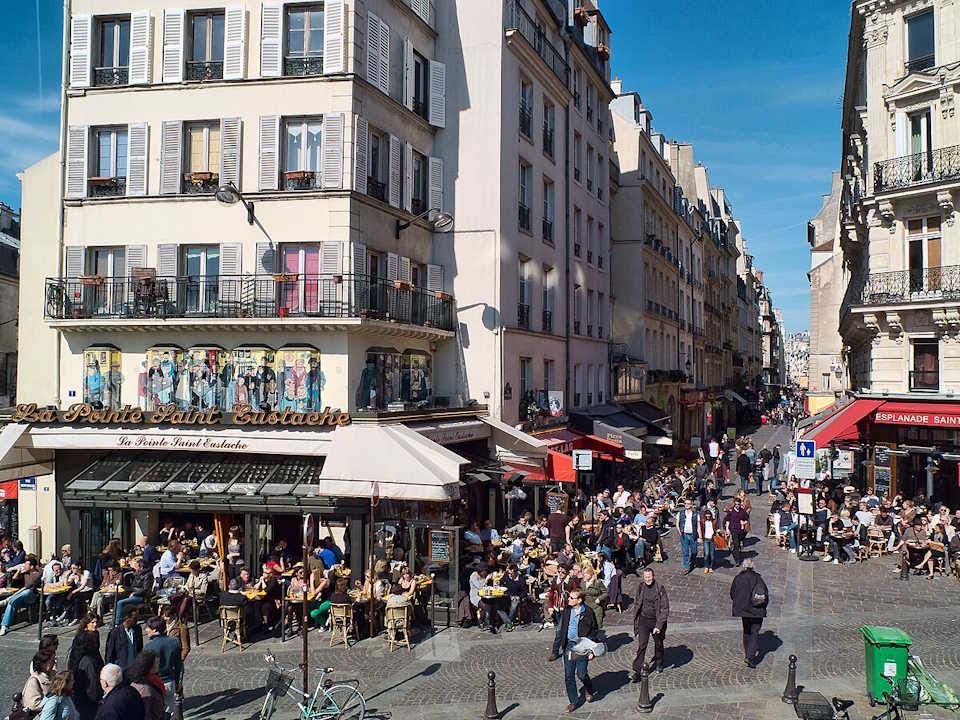
When we lament the isolation of the suburbs, we’re not really lamenting low residential density; we’re lamenting the isolation of houses from third spaces where people might meet and mingle. Those third spaces are shops.
Recently, in response to someone complaining that new American apartments all look the same, I tweeted that instead of posting pictures of urban environments they don’t like, people should post more photos of cities they do like. Many people took me up on that challenge. Some people posted aerial photos and others jokingly posted screencaps from video games and movies. But the ones who posted street-level photos often chose streets with lots of shops.
You need shops to make a city great.
Limit physical size, not corporate size
One good thing about the idea of filling cities with small businesses is that it has the potential to appeal to a bunch of different political factions. Conservatives may appreciate that small business turns lots of people into capitalists, giving them a stake in the capitalist system in general. Moderate urbanists will appreciate that small business requires things like public safety and good public transit. And progressives, with their focus on fighting the power of big corporations, will like that small businesses are small:
Small businesses are not economically efficient, but they create some positive externalities for cities. The higher a density of small retail businesses you have in an urban area, the more novelty local consumers can enjoy, and the more serendipity people can get from just walking around.
You don’t always get this benefit with big chains. Walking around in a fashion district that just has Zara and Vuitton and Gucci and other international chains is kind of boring — you could go anywhere and get that stuff, and there won’t be much that’s new or unexpected. But walking around in a neighborhood like Harajuku or St. Mark’s Place, with their proliferation of small independent boutiques, is a thrilling adventure. The same is true of restaurants; a street lined with chains isn’t going to be as interesting as one lined with places you’ve never tried, even if the chains are top quality.
So good urbanism sacrifices some efficiency in exchange for variety. There are various ways to achieve that outcome — you can severely limit chain stores, as San Francisco does. But a better approach is probably to limit the physical footprint of stores instead.
Chain retail is all about efficiency, which discourages chains from occupying small spaces — it’s usually not going to make economic sense to make a tiny Zara or a hole-in-the-wall T.G.I. Friday’s. But an indie bakery or a specialized bar or an unusual boutique can easily set up shop in a small space.
And when chain businesses do set up shop in a small space, it often fails to detract from the overall variety and serendipity of a retail district. In Japan, for instance, city centers have huge amounts of 7-Elevens, Lawsons, and Family Marts, but this doesn’t make Tokyo any less vibrant than New York City, where the bodegas are mostly independent.
Shrinking the size of shops also has direct benefits — it allows you to fit more shops in a given area, which increases novelty, variety, and serendipity.
Thus, one helpful policy for creating a city full of shops is to use zoning laws, building codes, and regulations to encourage small retail footprints in walkable neighborhoods. Japan had a law against large stores for many years, which is one reason its cities have so many small shops today.
How to get a city full of shops
There are lots of other legal and regulatory measures that can help fill an urban area with shops. One crucial step is simply to remove red tape, so that it’s easy for people to start small retail businesses. San Francisco notoriously has huge amounts of red tape. Here’s one testimonial from last year:
Five years ago, I decided to pursue my dream and launch Arcana, a wine bar, restaurant and entertainment venue on the Mission Street corridor. Little did I know what it would take to open those doors: years of hard work, heartache, blind alleys and bad-faith conversations…As I started my application process with the city, I was told that I should engage with neighborhood “stakeholders” for their approval…
[T]he Mayor’s Office of Economic and Workforce Development…sent me on a year-long journey talking to pressure groups abusing the conditional use authorization process. Contrary to official rules, these groups demanded that Arcana close at 10 p.m., imposing guidelines on the venue’s design, the artists we could hire and even the food we could serve, telling us we were not allowed to be a vegan restaurant…
The neighborhoods that need investments and resources the most are still tied up in red tape…[C]onverting an office space to an entertainment venue still takes months…Business operators must also pass inspections by the San Francisco Fire Department, Department of Public Health and Department of Building Inspection for plumbing, electrical and building compliance. Waiting for a license from the Department of Alcoholic Beverage Control, which includes an FBI background check, adds two to six months. This administrative and financial burden can quickly turn into a dead end and sap even determined entrepreneurs’ energy, determination and bank accounts.
Similar stories abound.
SF’s new mayor, Daniel Lurie, is making a concerted attempt to change things. He recently rolled out a package of regulatory reforms and legislation aimed at making it much easier to start a small retail business:
Small businesses and homeowners in San Francisco: permitting is about to get easier. Today, we announced reforms and legislation that will make permitting faster, simpler, and more transparent. These ordinances will cut red tape, save time and money, and finally make our permitting system work for the people it’s supposed to serve. Here are some examples of what this means in practice:
No more permits for sidewalk tables and chairs—putting $2,500 back in the pockets of small businesses and saving them valuable time…No more permits and fees to put your business name in your store window or paint it on your storefront…No more trips to the Permit Center to have candles on your restaurant’s table…No more rigid rules about what your security gate must look like so businesses have more options to secure their storefronts…No more long waits or costly reviews for straightforward improvements to your home, like replacing a back deck…And we’re getting rid of outdated rules to give downtown businesses more flexibility with how to use their ground-floor spaces—because if adding childcare centers and gyms will help bring companies and employees back downtown, we should support it.
In addition, every city department involved in permitting will track timelines and publish them online. We’re building one system—simple, accessible, and focused on the customer…And we’re not done…In the coming months, we’ll roll out a consolidated permit application and bring more of the process fully online.
When we make it easier to open a business, improve a home, or invest in our city—we don’t just support individual success. We fuel our city’s economic recovery…We attract more customers, more residents, more small business owners—and with them, the revenue and energy that San Francisco needs to thrive…Learn more about the initiative at https://sf.gov/permitsf
To what degree this actually clears out red tape remains to be seen, but it sounds like a great start, and I like the focus.
You also need to change a city’s zoning regulations to encourage lots of retail. Urbanists always talk about “mixed-use” development, but that can mean many things. It could mean a single big-box store or shopping mall located in the middle of a residential neighborhood, or a couple of small cafes in an otherwise residential area. In order to create high commercial density, zoning should allow retail anywhere on the ground floor of a central urban neighborhood. Cities should also think about alternative retail locations, like underground shopping areas, shopping arcades, or zakkyo buildings (multi-level retail with visible signs and street access to upper floors). In more residential neighborhoods, smaller numbers of grocery stores, restaurants, and cafes should still be allowed.
Shops require foot traffic, so cities need to promote walkability in shopping areas. This means removing surface parking lots and putting in parking garages instead. It means putting in sidewalks and protecting them from car traffic with physical barriers like trees, lampposts, fences, and bollards. And of course it means building public transit, so not everyone has to drive their car to a shopping area.
Finally, a city has to provide both public safety and public order in walkable areas. If looting of stores is tolerated, as it was in much of California in the years after the pandemic, small businesses are not going to take the risk of setting up shop in the area. If customers have to step over fentanyl users to get to their restaurant, they’re going to stay home and use DoorDash or drive to the mall instead.
Creating vibrant, walkable shopping districts is not trivial. But it’s crucial for creating the kind of city where people really want to live. If you expect citizens to give up the comfort of huge suburban houses and leafy green lawns and move to the city center, they have to be compensated in some way. Having a huge variety of stores and restaurants and bars and cafes within easy walking distance is that compensation.
More American urbanists need to be talking and thinking about how to fill our cities with shops.
This name refers to the building materials used, not to the number of floors in the building.



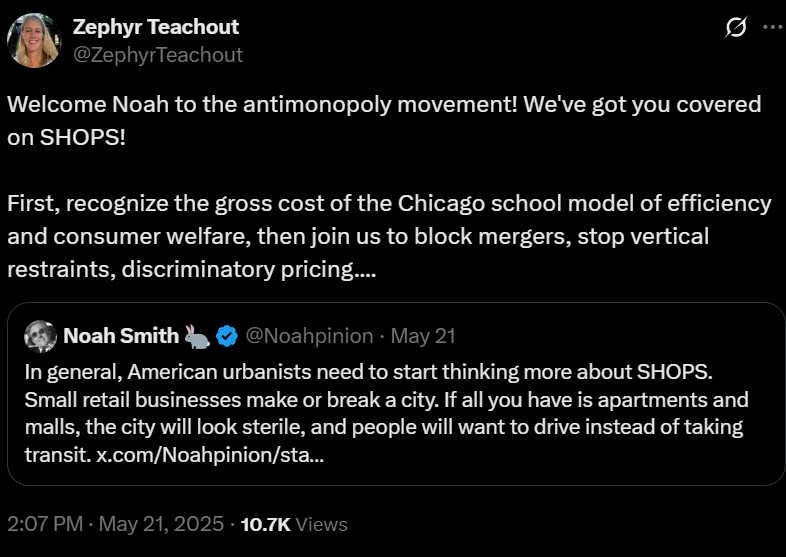
> No more permits for sidewalk tables and chairs—putting $2,500 back in the pockets of small businesses and saving them valuable time…No more permits and fees to put your business name in your store window or paint it on your storefront…No more trips to the Permit Center to have candles on your restaurant’s table…No more rigid rules about what your security gate must look like so businesses have more options to secure their storefronts…No more long waits or costly reviews for straightforward improvements to your home, like replacing a back deck
Jesus Christ! How did these busybodies who thought any of this was a good idea in the first place get put in charge of anything? I don't think anything is really going to change without a wholesale change in leadership. The type of person who comes up with this stuff will just come up with new rules to replace the old. Maybe DOGE is right. Just fire them all and ask questions later.
Great article, thanks !
=> "Paris’ Haussmann apartments are usually either very close to shops, or built right above them:"
Just a small Parisian note: this charming street isn’t actually Haussmannian 🙂 The buildings here are older—likely late 18th to early 19th century—so they predate Haussmann’s redesign of Paris. Fewer floors, simpler façades, and irregular alignments give it away. Still very classic Paris, just a different era!
That said, you're absolutely right that Haussmannian buildings were designed to include ground-floor shops—they played a key role in activating the street and supporting urban life!